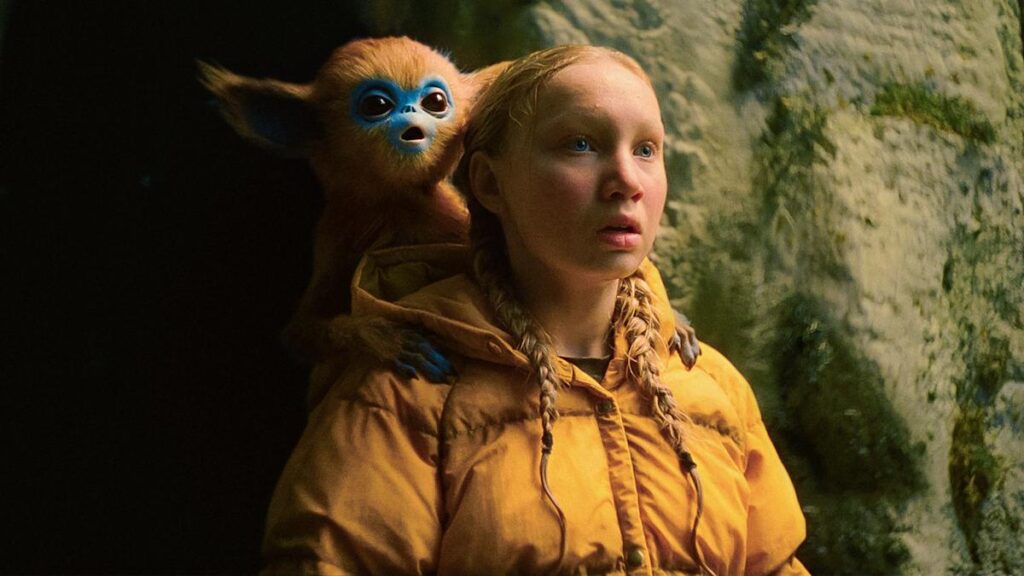
Helena Zengel and Ochi in <em>The Legend of Ochi.</em><span class=caption-credit> (A24)</span>
The Legend of Ochi: How Traditional Puppetry Brings Magic to Modern Cinema
A captivating scene from The Legend of Ochi showcasing the film’s unique practical effects. (Credit: A24)
A Bold Vision in Modern Filmmaking
In an era dominated by CGI blockbusters, The Legend of Ochi stands as a testament to the enduring power of traditional filmmaking techniques. This original story, brought to life by director Isaiah Saxon, challenges contemporary filmmaking conventions by embracing complex puppetry and practical effects, reminiscent of beloved classics from the ’80s and ’90s like Roald Dahl’s The Witches.
“The attempt to make the film took longer than the making of the film… I think it’s extremely hard to reach kids with your first film because kids are kind of behind this kind of corporatized IP world now. But I really wanted to reach kids with my first film.”
– Isaiah Saxon, Director
The Journey to Production
Saxon’s dedication to his vision led to years of meticulous preparation. Each bit of funding was invested in prototyping creatures with London’s prestigious John Nolan Studios, known for their work on Jurassic World Dominion. The process included extensive location scouting in Romania, culminating in a visual package that finally convinced A24 to take a bold risk on this unique project.
A Story of Mystery and Wonder
The film follows Yuri (Helena Zengel), a young girl living in the remote village of Carpathia, where mysterious primates called the Ochi are feared by locals. Her father Maxim (Willem Dafoe), a Viking armor-wearing conservative figure, leads hunting parties against these creatures. The story takes an unexpected turn when Yuri encounters a young Ochi, challenging everything she’s been taught to believe.
Key Production Elements:
- Complex puppetry by John Nolan Studios
- Five puppeteers coordinating each Ochi scene
- Custom-built sets for puppet operation
- Filming in the Carpathian wilderness
- Blend of practical and digital effects
The Art of Puppetry
The decision to use puppetry over pure CGI was rooted in both artistic and practical considerations. The infant Ochi puppet, with its large eyes and protruding ears, creates an immediate physical presence that actors can genuinely interact with. The imperfections in rod puppeteering actually enhanced the character’s authenticity, mimicking the natural movements of a baby primate.
“Puppetry is such an ancient art form. We’ve been making shadows on the cave wall for thousands of years, and our brain as we watch the human hand give life to a character is just fully accepting of it.”
– Isaiah Saxon on choosing puppetry
Behind the Scenes Magic
The complexity of bringing the Ochi to life required extraordinary coordination. Five puppeteers, led by Rob Tygner, work in unison to control the creature’s body and expressions. Two additional operators manage the puppet’s facial features while monitoring displays, creating a seamless performance that requires perfect synchronization.

Behind-the-scenes look at the intricate puppetry work in The Legend of Ochi. (Credit: A24)
Balancing Tradition and Technology
While Saxon champions practical effects, he acknowledges the value of digital tools. The film employs CGI for distant shots and virtual sets, demonstrating a thoughtful approach to combining traditional and modern techniques. This hybrid approach allows the film to maintain its practical magic while leveraging technology where it makes sense.
“You have to look at each opportunity and come to the technique organically for the task. You can’t have philosophies about this.”
– Isaiah Saxon on mixing techniques
A Vision for Independent Filmmaking
Saxon’s commitment to original storytelling extends beyond The Legend of Ochi. Despite potential opportunities in franchise filmmaking, he remains dedicated to creating unique, independent stories. His stance against working on existing IP properties reflects a broader vision for preserving creative independence in modern cinema.
The Legend of Ochi represents more than just a film; it’s a testament to the enduring power of traditional filmmaking techniques in the digital age. Through its innovative use of puppetry and practical effects, it demonstrates that there’s still room for handcrafted magic in contemporary cinema, proving that sometimes the old ways can create something remarkably new.





